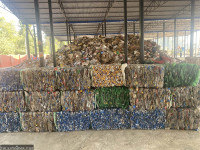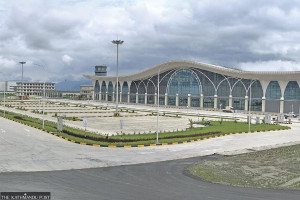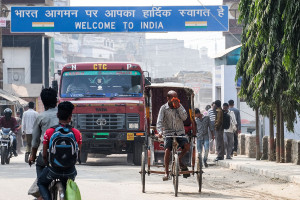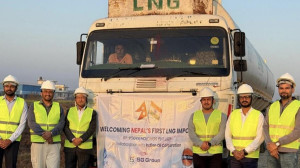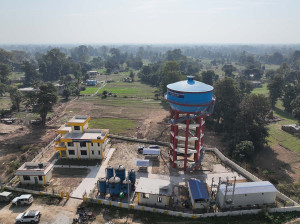Money
Nepal’s FDI pledges soar, but actual inflows stay paltry
Corruption, red tape and policy instability repel investors.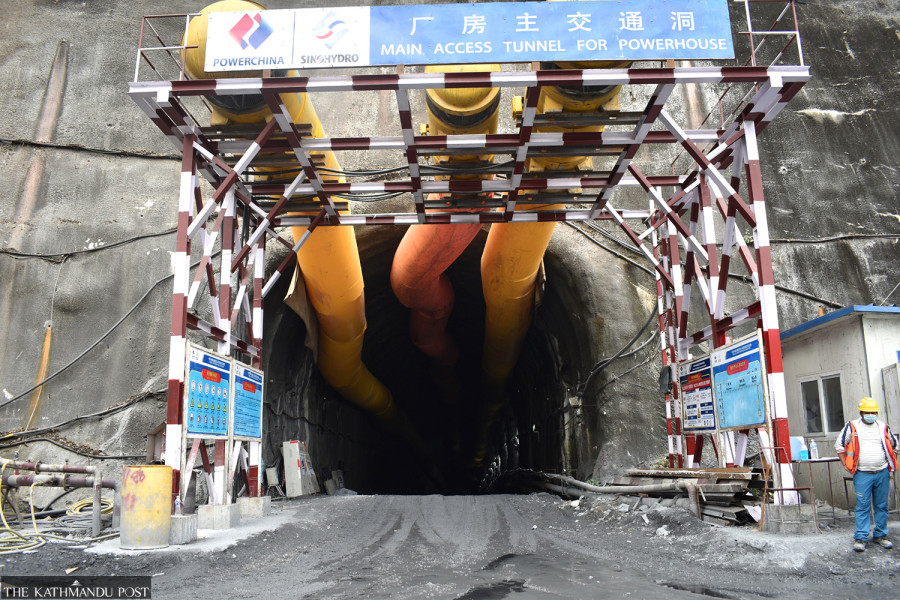
Sangam Prasain & Krishana Prasain
Nepal received record-high foreign direct investment (FDI) commitments in the past fiscal year, which ended mid-July. But despite the promises, the actual inflow of FDI was less than a fifth of the pledged amount, underlining a long-standing challenge in the country’s investment climate.
According to Nepal Rastra Bank, the central bank, net FDI stood at Rs12.02 billion last fiscal year, against commitments of Rs64.96 billion.
The inflow was an improvement of 41.91 percent compared to the previous year, but the gap between commitments and realisation continues to be glaring.
Experts say procedural delays, outdated laws, and rampant corruption are the key reasons behind this mismatch. “Foreign investors will no longer show interest unless Nepal’s ‘licence rule’ ends,” said Nara Bahadur Thapa, former executive director of Nepal Rastra Bank.
He pointed out that bribes are handed out not only when licences are granted but also when they are enforced, discouraging potential investors from bringing in capital.
This entrenched cycle of rent-seeking, experts argue, reflects Nepal’s deep-rooted nature of kleptocracy, where political figures, business elites, and even criminal intermediaries collude to extract benefits for themselves.
Meanwhile, neighbouring India has been aggressively moving ahead with reforms to attract more foreign investment. India has scrapped the pre-approval process in national priority sectors, cut a range of tariffs, and assured investors that they can import raw materials and export goods without facing additional costs. Many other countries have followed suit, but Nepal still clings to its licence regime.
“Pre-approval is a major obstacle. The registration process should be automatic for priority sectors,” said Thapa. He added that Nepal’s non-investment grade in international ratings sends a clear signal to the global market that the country is not investor-friendly.
“Besides, the never-ending political instability continues to hurt investment,” he said.
India’s example, experts say, demonstrates how regulatory reforms can bring in investment. But Nepal has failed to learn from its neighbour.
The gap between commitments and realisation reflects not only bureaucratic inertia but also corruption in the system, analysts say. Though officials argue that the so-called automatic route has boosted commitments, foreign investors remain hesitant to proceed further.
“Pre-approval does not mean much unless the investment process is genuinely simplified,” said Thapa.
Despite claims that the economic situation has improved, investors remain cautious and are largely in a wait-and-see mode.
Nepal has not been able to address the issues identified in the World Bank’s Doing Business report, which consistently ranks the country low in terms of ease of doing business.
Thapa stressed that genuine economic reforms are yet to take place.
“Whatever improvement is being made is only for the benefit of middlemen and not for the economy as a whole. No serious study is being carried out, and no commission has been formed for actual economic reform,” he said.
According to him, if Nepal was truly pursuing reforms, the pre-approval requirement for foreign investment would already have been removed. The contrast is stark: while India has secured an investment-grade rating, Nepal remains stuck with a non-investment rating, which makes investors wary. “Investors care about investment grading, and that’s what matters,” said Thapa.
The latest World Investment Report 2025, published by the United Nations Conference on Trade and Development (UNCTAD) in June, also paints a bleak picture. It showed Nepal’s FDI inflows fell to $57 million in 2024, down from $185 million in 2019—a sharp 69.18 percent decline over five years.
Experts say the fall in FDI has cast a long shadow over Nepal’s ambition to graduate to middle-income status by next year.
The government frequently organises investment summits and promotional events, but these efforts are often undermined by weak follow-through, systemic barriers, and the absence of sustained reform.
Nepal’s history of failed and stalled foreign investment projects further discourages new investors.
The most prominent case is the West Seti Hydropower Project, once touted as a game-changer for Nepal’s energy sector.
Over the decades, it attracted big foreign players—including Australia’s Snowy Mountain Engineering Corporation, China’s Three Gorges Corporation, and later PowerChina—but political wrangling, bureaucratic red tape, and shifting policy priorities ensured the project never materialised.
In 2018, the government terminated the license of the Chinese developer, leaving the $1.6 billion project in limbo.
Another example is the Budhi Gandaki Hydropower Project, which has been repeatedly awarded (and scrapped), most notably with China Gezhouba Group Corporation.
The project has become a symbol of political interference, with successive governments reversing decisions depending on which coalition is in power. This inconsistency has signalled to the world that Nepal cannot guarantee the stability or predictability foreign investors seek.
Even in the industrial sector, FDI projects face obstacles. The Huaxin Cement Project, a Chinese investment in Dhading, faced years of delay due to land acquisition disputes, environmental concerns, and long bureaucratic approval processes.
One of the most telling examples of Nepal’s inability to retain foreign investors was the case of the Dangote Group, Africa’s largest cement producer, owned by billionaire Aliko Dangote. The Nigerian conglomerate strongly expressed interest in establishing a multi-billion-rupee cement factory in Nepal nearly a decade ago.
Dangote planned to bring in large-scale investment, technology, and expertise to tap into Nepal’s abundant limestone reserves.
But the project never took off. Company officials cited endless procedural delays, lack of government coordination, and a complex regulatory environment. Land acquisition disputes, lengthy approvals, and what they described as an “unpredictable policy climate” ultimately forced them to shelve the project.
The exit of Dangote was widely seen as a missed opportunity for Nepal. Not only did it signal to the international community that big global players find Nepal unattractive, but it also undermined the government’s frequent claims of creating an investor-friendly environment.
Though eventually operational, Huaxin Cement Project’s struggles reinforced the perception that doing business in Nepal requires navigating endless obstacles. Similarly, investments in the information technology and tourism sectors, though attracting large pledges, have seen little on-the-ground progress.
Another major setback to Nepal’s investment image has been its re-inclusion in the Financial Action Task Force (FATF) grey list, which flags countries with strategic deficiencies in combating money laundering and terrorist financing.
Being placed back on the grey list not only increases scrutiny of Nepal’s financial transactions but also raises the cost of doing business, as global banks and investors see added compliance risks when dealing with Nepali institutions.
Experts say grey-listing acts as a red flag for foreign investors, who are wary of potential difficulties in profit repatriation, cross-border payments, and international partnerships.
“When a country is on the grey list, it signals to the world that the financial system is weak and risky,” said a senior economist, who wished not to be named.
For Nepal, already struggling with poor ratings and political instability, the grey-listing has compounded doubts over its credibility as a secure investment destination.
Last November, Fitch Ratings assigned Nepal a long-term foreign-currency Issuer Default Rating (IDR) of ‘BB–’ with a stable outlook. The rating reflected some strengths—low external borrowing, strong liquidity, and solid growth potential driven by the hydropower sector. But it also underscored deep weaknesses.
According to Fitch, Nepal’s minimal foreign direct investment and limited integration into the global financial system have held the country back.
Burdensome procedures for profit repatriation and restrictions on external transactions have historically constrained inflows, though authorities are now trying to address these issues.
Still, political instability remains the single biggest concern. Fitch highlighted that Nepal has witnessed eight changes in government since 2014, with recurrent power struggles and shifting alliances undermining long-term policymaking.
Development planning is often interrupted midway, leaving investors uncertain about the continuity of policies.
The message from both experts and international institutions is clear: Nepal’s investment climate will not improve until it addresses corruption, streamlines procedures, and creates a predictable policy framework.
Without these changes, Nepal risks being left behind in the regional competition for foreign capital, even as its neighbours accelerate reforms to attract investors.




 19.12°C Kathmandu
19.12°C Kathmandu




